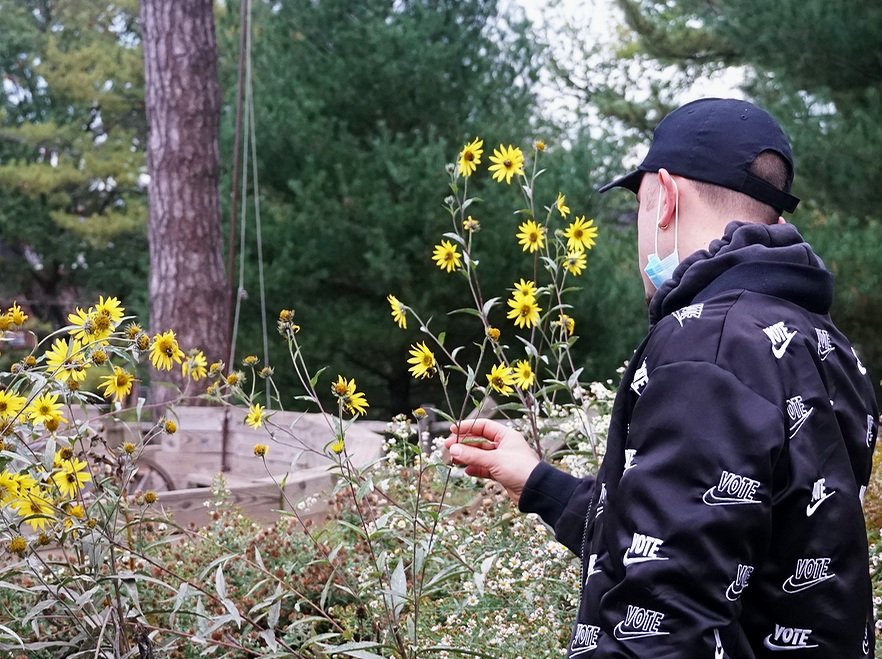Written by Mackenzie Younger
There is nothing like a beautiful outdoor space in the fall! This is especially true in October when a garden can be a delightful mix of late-season blooms, incredible fall foliage, and a relaxing place to enjoy fresh air before winter. But have you ever thought about creating a spooky, Halloween-themed landscape with native plants? Here are our Top 10 Native Plants for Halloween!
Baby 'bear' (Mackenzie's pup) with pumpkins
1. Pumpkin
Pumpkins are an iconic symbol of fall, often associated with Halloween and Thanksgiving. Scientists believe that pumpkins originated in North America about 9000 years ago. The oldest pumpkin seeds were found in Mexico and date back to somewhere between 7000-5550 B.C
Growing pumpkins can be a rewarding experience, whether you're interested in carving jack-o'-lanterns, making pumpkin pies, or simply enjoying the decorative aspect of these vibrant fruits. No Halloween is complete without pumpkins!
Did you know pumpkin seeds are also rich in Zinc? Create a super salad by adding roasted pumpkin seeds as a garnish!
Indian Corn
2. Corn
Corn, also known as maize, has a complex and interesting history and like pumpkins, has been grown by indigenous peoples in North America for thousands of years. Decorative corn, often known as Indian corn or ornamental corn, is very common in Halloween decorations.
When it comes to growing ornamental corn, we suggest using the Three Sisters garden method, a traditional Native American planting technique of growing corn, beans, and pumpkins (or squash) together. This method maximizes space, enhances soil fertility, and provides mutual benefits for the crops.
Did you know Indian corn can also be used in corn meal and it is far better for you than what is typically sold in cans? The more colorful the corn is, the more antioxidants it has!
Giant sunflower | Helianthus giganteus | Fort Greene Park, Brooklyn
3. Sunflowers
The sunflower (Helianthus annuus) has a very similar history to pumpkins and corn and was grown by Native Americans in their vegetable gardens alongside these other iconic plants. Eventually, the sunflower was introduced to Europe by Spanish explorers in the 16th century and today sunflowers are one of the most recognizable and common garden flowers in the world.
If you plant sunflower seeds late in the season, say mid-June or July, they will mature and flower late into October, just in time for Halloween! The dead seed heads can also be used to make spooky decorations.
Annual sunflowers can be fun and easy to grow in a garden but we’d also suggest planting native perennial sunflowers. Jerusalem artichoke (Helianthus tuberosus) Giant sunflower (Helianthus giganteus) Willow-leaf sunflower (Helianthus salicifolius) and Maximilian’s sunflower (Helianthus maximiliani) all flower late into the fall. Depending on where you live, many of these will be flowering during Halloween.
Did you know many species in the Helianthus family are also the host plants of several native butterflies? These include the Painted Lady and the Silvery Checkerspot!
'Autumn Blaze' Red maple | Acer rubrum | Dutchess county, NY
4. Maples
Sugar maple (Acer saccharum) is renowned for its brilliant fall foliage. The leaves turn various shades of yellow, orange, and red, creating a spectacular display in autumn. We suggest using the cultivars 'Green Mountain’ or ‘Fall Fiesta’ for more consistent and brilliant orange foliage.
Red maple (Acer rubrum) is one of the most common and widespread maples in North America and can be used much further south than the sugar maple. It's also far more adaptable to extreme growing conditions like what you find in cities, making it a great street tree. Cultivars like ‘October Glory’ and ‘Autumn Blaze’ have long-lasting displays of brilliant red foliage and can be found in most nurseries.
No Halloween is complete without maples and their memorial fall foliage!
5. Switchgrass
Switchgrass (Panicum virgatum) is a warm-season perennial grass native to North America. It is a versatile and hardy grass species that can be used in small gardens as a landscape ornamental and in large landscapes to create a wildlife habitat.
When you think of Halloween, grasses are probably not the first thing that comes to mind, but let me assure you, switchgrass makes a great addition to the fall landscape. In October, the grass goes dormant but keeps its upright form. These dried grass blades blow around in the wind, producing fun and eerie sounds ideal for Halloween. They can also be cut and used to stuff scarecrows. This native grass creates a wonderful garden atmosphere while providing lots of material for practical and or decorative applications.
Switchgrass has many cultivars. ‘Shenandoah’ with its red tips can really stand out amongst perennials in the flower garden.
'Raydon's Favorite' Aromatic aster | Aster oblongifolius | Wallkill, NY
6. Aromatic Aster
Aster oblongifolius, commonly known as Aromatic Aster or Fall Aster, produces daisy-like flowers with yellow centers and violet-purple rays. It's a fantastic plant for the Halloween garden and the last native perennial to flower. Late-season pollinators will thank you for having this plant in your garden, especially the last monarchs to migrate south.
Aromatic aster is also a great alternative to mums which are very popular at this time of the year but do very little good in terms of helping local pollinators. So — if you’re looking to extend the flower season and want to add a burst of purple to the Halloween garden, this is the plant for you! We suggest using the cultivar ‘Raydon’s Favorite’ and you won’t be disappointed.
'Meader' American persimmon | Diospyros virginiana | Mackenzie's Garden, Ellenville, NY
7. Persimmon
The American persimmon (Diospyros virginiana) is a relatively common native tree down south and can be found along roads and old fields but unfortunately, it can be hard to find in nurseries. If you can find it, the persimmon is a great option, as it produces absolutely delicious fruits that often ripen right around Halloween.
The flavor of the American persimmons is similar to an apricot dipped in honey and for that reason, it's perfect for the sweet tooth holiday. These fruits can be eaten fresh or used to make natural candies or baked in cakes and pies.
We suggest getting self-fertile cultivars like ‘Meader’ persimmon because otherwise, you’ll need a male and female tree to cross-pollinate. Only the females produce fruit.
Did you know, that many places in the Midwest have persimmon festivals each fall to celebrate the tradition of harvesting the wild fruit? Prizes are awarded for those who bake the best cakes! The persimmon tree is also the host plant of the beloved Luna moth.
8. American smokebush
If you are looking for vivid fall foliage but don’t have room for maples in your garden or simply want to add something really unique to your landscape, the American Smokebush (Cotinus obovatus) is the plant for you!
This rare native turns brilliant shades of red, orange, and purple in the fall — making it one of the absolute best trees for fall foliage.
The American smokebush is a large shrub / small tree, with beautiful bark and whimsical blooms that share a resemblance of smoke. It can be easily be confused with the European smokebush which is more common in nurseries, for its purple foliage. While the European cultivar is nice, it doesn’t put on a dazzling display in the fall like the America Smokebush. That's why we recommend this native plant for Halloween.
Staghorn sumac | Rhus typhina | Boothbay, ME
9. Sumac
Although common in the landscape along roads and in open areas, our native sumacs can also make wonderful additions to any garden. There are several reasons why sumacs might make sense for you. For one, they have a rather unique form that looks almost tropical. They produce berries which birds enjoy and they have some of the most vivid red and orange fall foliage. Pollinators love their blooms.
Winged sumac (Rhus copallinum) produces consistent hues of red and Burgundy, while the Stag-horn sumac can be fire-like in its appearance, ranging from yellow to orange and red all within one plant. But, and this is a big but… this plant can spread (aggressively) over time. Unless you have a large outdoor space where a mass planting can take place, you might want to consider planting your sumac in a pot or container.
Come Halloween this native plant won’t fail you with its explosive fall colors. Add pumpkins and cobwebs around this sumac for a delightful Halloween installation
Scarlet Oak | Quercus coccinea | Longwood Gardens, PA
10. Scarlet oak
Oaks aren’t known for great fall color, in fact, most oaks really fail in this department but the scarlet oak (Quercus coccinea) is a different story.
This native tree goes red and bright red at that and retains its leaves for a long period of time after most trees have lost their leaves. These dry leaves create a rustling sound in the wind which can be calming or spooky on Halloween.
Scarlet oak, like all oak trees, gets big and needs space. It's fast-growing and a great option for large yards or parks. If you like red fall foliage in particular, this tree is a great option and we recommend planting scarlet oak with other native trees such as sourwood, tupelo, and red maple to enhance this experience.
If you enjoyed this article on the Top 10 Native Plants for Halloween, you’ll love the Top 10 Native Plants for Red Fall Foliage (coming next week!)













